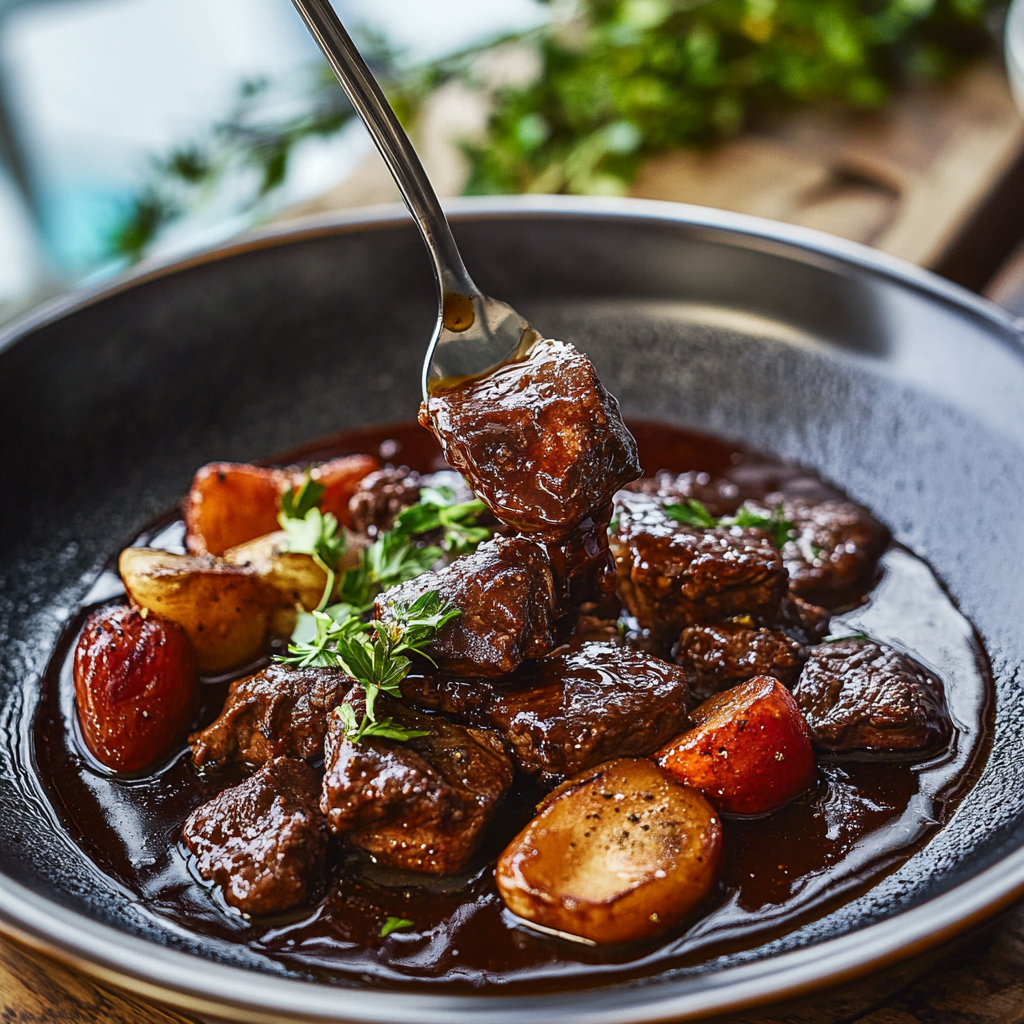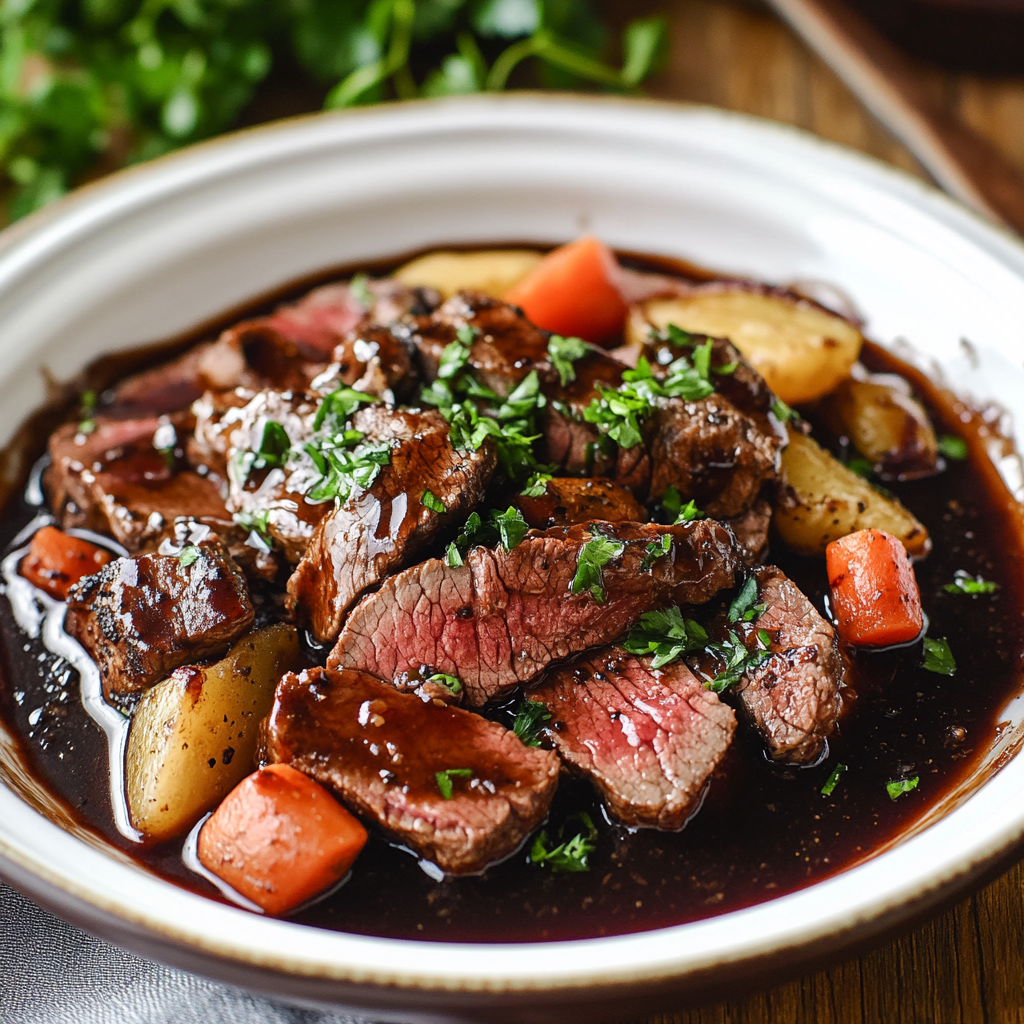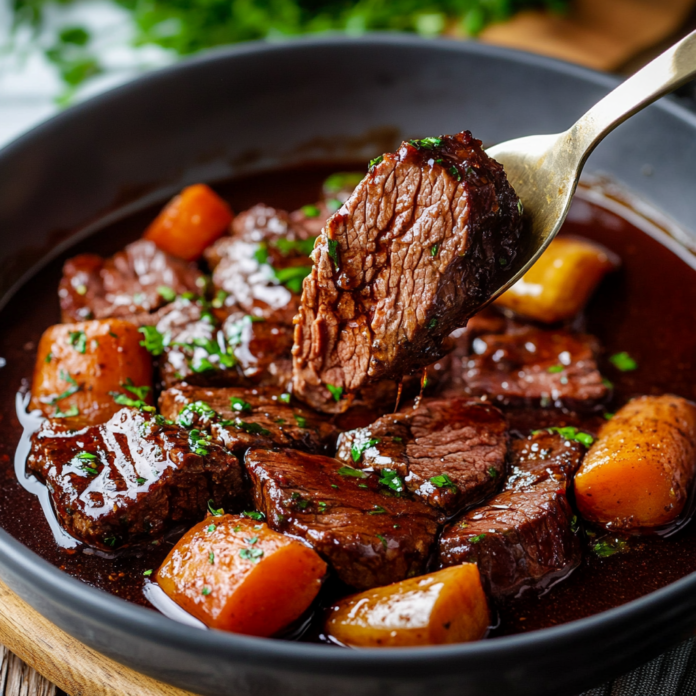Introduction and Quick Summary
Beef with balsamic reduction is a dish that marries rich flavors and an elegant presentation. The combination of tender beef and the tangy sweetness of balsamic vinegar creates a mouthwatering experience that is perfect for special occasions or a cozy dinner at home. This recipe is not only straightforward but also offers a unique twist on traditional meat dishes.
Imagine serving perfectly seared beef drizzled with a luscious balsamic reduction that elevates the flavors to another level. The acidity from the vinegar balances out the richness of the meat, resulting in a well-rounded dish that tantalizes the taste buds. Whether you’re cooking for family or entertaining guests, this recipe will impress everyone at the table.
In this article, you will find detailed instructions on how to prepare this delectable dish along with tips for serving and storing it. We will cover all the essential ingredients you need to create this culinary delight. Get ready to indulge in a dish that marries simplicity with sophistication—the perfect balance for any meal!
Main Ingredients
Beef
For this recipe, you will need approximately 2 pounds of high-quality beef. Ribeye or sirloin steaks are excellent choices as they provide the best flavor and tenderness when cooked. Look for cuts that have good marbling, which enhances the juiciness of your final dish.
Balsamic Vinegar
You will require 1 cup of aged balsamic vinegar for the reduction. Aged balsamic has a deeper flavor profile compared to regular vinegar, making it ideal for sauces. It brings sweetness and acidity to balance the richness of the beef and helps create that glossy finish in your dish.
Olive Oil
Extra virgin olive oil is essential in this recipe; you’ll need about 2 tablespoons. It not only adds flavor but also helps to sear the beef properly. The oil has a higher smoke point than butter, making it perfect for achieving that beautiful crust on your steak.
Garlic
Two cloves of garlic minced will infuse your dish with aromatic flavors. Garlic complements both beef and balsamic vinegar beautifully, adding depth without overpowering the other ingredients.
Fresh Herbs
Using fresh herbs like rosemary or thyme enhances the dish’s flavor complexity. You’ll want about 2 tablespoons of chopped herbs mixed into your sauce right at the end of cooking. These herbs pair wonderfully with both the meat and vinegar.

How to Prepare Beef with Balsamic Reduction
Step 1: Preparing the Beef
Start by taking your steaks out of the refrigerator about 30 minutes before cooking them. This allows them to reach room temperature for even cooking. Season both sides generously with salt and pepper—this enhances flavor while creating a savory crust during searing.
Heat 2 tablespoons of olive oil in a large skillet over medium-high heat until shimmering but not smoking. Carefully place each piece of seasoned steak into the pan without crowding; this ensures they sear properly instead of steaming. Cook each side for about 4-5 minutes depending on thickness—aim for medium-rare at an internal temperature of about 130°F (54°C). Once done, transfer them onto a plate to rest while you prepare your sauce.
Step 2: Making the Balsamic Reduction
In the same skillet used for cooking your steaks, add minced garlic and sauté for about 30 seconds until fragrant—be careful not to let it burn! Next, pour in 1 cup of aged balsamic vinegar and bring it to a simmer over medium heat. Use a wooden spoon to scrape any browned bits off the bottom; these add incredible flavor.
Allow the vinegar to reduce by half—this should take around 10-15 minutes—until it thickens slightly into a syrupy consistency. Adjust seasoning if necessary by adding salt or pepper according to taste. Once reduced, remove from heat and stir in fresh herbs right before serving; this keeps their flavors vibrant.
Step 3: Serving Your Dish
Once your steaks have rested adequately—about five minutes—you can slice them against the grain into strips if desired or serve them whole atop plates. Drizzle generously with your homemade balsamic reduction over each steak piece ensuring every bite gets that rich sauce draped over it.
Consider pairing this dish with sides such as creamy mashed potatoes or sautéed vegetables which complement its robust flavors nicely! Don’t forget some crusty bread on hand too; it’s perfect for soaking up any leftover sauce!
Serving and Storing Tips
Serving Suggestions
For an impressive presentation when serving your beef with balsamic reduction, consider plating techniques that highlight both color and texture on each plate! Arrange slices neatly over mashed potatoes or alongside roasted seasonal vegetables like Brussels sprouts or asparagus—they provide vibrant colors while balancing out flavors beautifully.
Add finishing touches by garnishing plates with fresh herb sprigs (such as rosemary) or drizzle extra reduced balsamic around edges—it gives an elegant touch! Pairing this succulent meal alongside full-bodied red wine like Cabernet Sauvignon elevates dining experiences too!
Storing Leftovers
If you happen to have leftovers after enjoying this delightful meal (which is rare!), allow cooked beef pieces cool completely before transferring them into airtight containers—this helps preserve moisture levels within meat during refrigeration! Store sealed containers in fridge where they can last up three days safely.
When ready to enjoy again simply reheat portions gently either microwave-safe plate covered loosely or stovetop over low heat ensuring not overcook which can dry out meat again! Consider reheating leftover sauce separately if desired so each bite retains all those rich flavors from original preparation! Enjoy indulging once more without losing quality!
Feel free following these guidelines as you embark on creating your own flavorful journey through preparing delicious Beef with Balsamic Reduction at home today!
Mistakes to avoid
When preparing Beef with Balsamic Reduction, it’s essential to steer clear of common cooking mistakes that can hinder your dish’s flavor and presentation. One critical mistake is not allowing the beef to rest after cooking. Resting helps redistribute the juices within the meat, resulting in a more flavorful and tender bite. Cutting into the beef too soon will lead to a dry texture, as the juices will escape.
Another frequent error is using low-quality balsamic vinegar. The quality of your balsamic reduction directly affects the overall taste of your dish. Opt for high-quality aged balsamic vinegar for a richer flavor profile. Additionally, some cooks rush the reduction process, failing to allow enough time for the vinegar to thicken properly. A well-reduced balsamic will have a syrupy consistency that complements the beef beautifully.
Overcooking the beef is yet another mistake to avoid. Cooking it beyond medium-rare can lead to tough and chewy meat. It’s crucial to use a meat thermometer to ensure precise cooking temperatures. Moreover, neglecting seasoning before cooking can result in bland beef. Always season generously with salt and pepper before searing to enhance both flavor and crust.
Lastly, failing to balance flavors in your reduction can detract from the dish. Consider adding herbs or a touch of sweetness with honey or brown sugar if needed. This balance can elevate your Beef with Balsamic Reduction and make it unforgettable.

Tips and tricks
To achieve perfect Beef with Balsamic Reduction, consider these practical tips and tricks that can enhance your cooking experience. First, ensure you select the right cut of beef. Tender cuts such as filet mignon or ribeye are excellent choices because they absorb flavors well while remaining juicy during cooking.
Before you begin, prepare all ingredients in advance. This mise en place approach helps streamline your cooking process and prevents last-minute scrambling when timing is critical. When searing beef, preheat your pan thoroughly; this step creates a beautiful crust on the meat while locking in moisture.
Pay attention to the thickness of your balsamic reduction; achieving that ideal syrupy consistency requires patience. Start by simmering over medium heat and allow it to reduce slowly without rushing this process. Additionally, consider incorporating aromatics like garlic or shallots into your reduction for added depth of flavor.
Don’t underestimate resting time! After cooking, let your beef rest under foil for about 10 minutes before slicing. This simple step ensures maximum juiciness in each bite while allowing flavors to meld together beautifully.
Finally, serve your Beef with Balsamic Reduction alongside complementary sides such as roasted vegetables or creamy mashed potatoes for a well-rounded meal that pleases any palate.
Suggestions for Beef with Balsamic Reduction
Enhancing your Beef with Balsamic Reduction can be achieved through thoughtful suggestions that elevate its presentation and taste. Firstly, consider marinating your beef beforehand in balsamic vinegar mixed with olive oil and fresh herbs like rosemary or thyme. This method infuses additional flavors into the meat while also tenderizing it.
For an impressive presentation, slice the cooked beef against the grain into thin strips before plating it elegantly on a serving dish or individual plates. Drizzle the balsamic reduction artfully over the sliced beef instead of pouring it indiscriminately; this technique enhances visual appeal and allows diners to appreciate every detail.
Incorporate seasonal vegetables either roasted or sautéed as sides; they add color and nutrition while contrasting textures nicely with the tender beef. Seasonal favorites include asparagus, carrots, or Brussels sprouts tossed in olive oil with salt and pepper before roasting.
Consider garnishing with fresh herbs such as parsley or basil just before serving; these bright greens add freshness and vibrant color that makes your dish pop visually on any table setting.
Lastly, pairing this meal with a fruity red wine like Pinot Noir complements both flavor profiles beautifully while enhancing overall dining experience.
FAQs
What type of beef is best for Beef with Balsamic Reduction?
Choosing the right cut of beef is crucial for creating an exceptional Beef with Balsamic Reduction dish. Tender cuts are ideal since they absorb flavors effectively while maintaining moisture during cooking. Cuts like filet mignon or ribeye are excellent options due to their tenderness and rich marbling which adds depth of flavor when paired with balsamic reduction sauce.
If you’re looking for something more budget-friendly yet flavorful, sirloin steak works well too! Its leaner nature still delivers great results when cooked properly without losing juiciness during preparation.
Regardless of which cut you choose, always remember seasoning generously before cooking! This simple step greatly enhances flavor profiles throughout every layer of this delicious dish!
How do I know when my beef is perfectly cooked?
Knowing when your beef is perfectly cooked is essential for achieving optimal tenderness in your Beef with Balsamic Reduction recipe! The most accurate method involves using a meat thermometer; aim for internal temperatures between 130°F – 135°F (54°C – 57°C) for medium-rare doneness—ideal for enjoying juicy bites filled with flavor!
Aside from temperature checks, observe visual cues like color changes happening on surface areas; beautifully browned exteriors indicate proper searing has taken place! Additionally feel free to apply gentle pressure on each piece—firmness signals how well-cooked they are inside!
Remember: Allow resting time post-cooking enhances final results significantly—juices redistribute throughout each slice making every bite irresistibly succulent!
Can I make this recipe ahead of time?
Yes! Preparing Beef with Balsamic Reduction ahead of time offers convenience without sacrificing taste! You can cook both components separately earlier in day then reheat them just before serving—making hosting gatherings much easier!
When preparing ahead: cook meat until slightly below desired doneness (about 5°F lower), allowing room during reheating process ensuring perfectly cooked results later on! Store leftover reductions separately covered tightly so they maintain their consistency without thickening excessively overnight!
Reheating takes little effort—simply warm up sauce gently over low heat until hot again but avoid boiling which could alter flavors!
What sides pair well with Beef with Balsamic Reduction?
Pairing side dishes along side Beef With Balsamic Reduction enhances overall dining experience significantly! Roasted vegetables such as asparagus drizzled lightly w/ olive oil & sprinkled w/ sea salt bring vibrant color & nutrition which contrasts beautifully against richness found within steak itself!
Creamy mashed potatoes also work wonderfully here—offering comfort alongside savory elements present throughout main course! For something lighter consider mixed greens dressed simply w/ vinaigrette—they provide crunchiness balancing out indulgent flavors throughout meal!
Ultimately choose sides based upon personal preferences—but ensuring textural contrasts keeps things exciting during enjoyment!
Can I use other vinegars instead of balsamic?
While traditional recipes emphasize using balsamic vinegar due its unique sweet-tart profile—it’s possible substitute different types if desired! Red wine vinegar offers similar acidity levels although lacks sweetness found within balsamic reducing need add sugar/honey accordingly adjust final taste accordingly!
Apple cider vinegar serves another option yielding fruity notes however may require further adjustments depending upon preferences regarding sweetness levels established overall dish!
Experimentation remains key finding suitable alternatives maintaining essence behind entire concept behind “Beef With Balsamic Reduction”—feel free get creative exploring various options available based upon personal tastes/preferences!
How long does it take to cook?
Cooking times vary depending upon exact thickness/cut chosen—but generally speaking one should expect around 10-15 minutes total preparation time including searing process involved within creation steps toward perfecting “Beef With Balsamic Reduction” dish itself!
A thicker cut may take longer than thinner slices so keep an eye on internal temperature readings using reliable meat thermometer ensuring safety precautions adhered across board while achieving desired levels achieved during preparation stages prior serving guests/family alike!
Conclusion
Creating a delectable Beef with Balsamic Reduction involves careful attention to detail, from selecting quality ingredients to mastering proper cooking techniques. Key tips for success include avoiding premature cutting of the meat, ensuring optimal juiciness. Thoughtful preparation, practice, and perseverance elevate the dish, showcasing culinary expertise and resulting in a meal that delights and satisfies. The experience is enhanced by complementary sides, presenting an elegant and balanced meal. Sharing such meals strengthens bonds and fosters connections, creating cherished memories with loved ones. Cooking is a celebration of life’s simplest pleasures—enriching hearts and nourishing souls. These shared moments remind us of the power of food to unite, inspire, and elevate our lives, offering opportunities for growth, learning, and creating legacies. Through the joy of preparing and enjoying food, we discover new experiences, embrace creativity, and cultivate unity, making the culinary journey both a personal and shared adventure.
